MAKING HISTORY
Press information
Hans Makart and the Salon Painting of the 19th Century
Venue
Lichtwark Gallery
Curator
Dr Markus Bertsch
Scientific Associate
Amelie Baader
With its impressive new presentation MAKING HISTORY, the Hamburger Kunsthalle is taking a remarkable step back into the past: the museum's largest painting–The Entry of Charles V into Antwerp (1878) by Hans Makart (1840–1884)–forms the centrepiece of an exhibit in which visitors can experience a vivid conception of the diversity and contradictions in the development of 19th-century art. The 50m²-sized, scandalous painting by the Austrian artist, which has captivated viewers since its initial presentation, can now be seen again for the first time after four years. Acquired for Hamburg's Kunsthalle in 1879, it is still one of the key images contributing to the museum's identity and is regarded as a highlight of historicist painting. Together with this work, 60 other 19th-century paintings and sculptures from the Kunsthalle's collection will be on display in the prestigious Makart Hall, including many of the paintings associated with the museum's foundation and opening in 1869. The work Cromwell and Charles I (after 1831) by Paul Delaroche (1797–1856) was donated in 1846, for example, on the condition that a public museum be founded in Hamburg. And Friedrich Karl Hausmann's (1825–1886) Galileo before the Dominican Council (1861) was donated to the Kunsthalle to mark the laying of the foundation stone in 1863.
In future, the aim of the Makart Hall–as the opening room of any tour through the museum's collection–will be to sharpen our visitors' reading of the exhibited works, encouraging both pleasure and criticism. What was once considered correct does not necessarily reflect today's ideas and values, but it can help us to question our own views. By means of a completely new staging within the space, the intention is for visitors to gain a sense of the 19th-century gallery ambience: referring to historical presentations of the collection, the works of art–some of which have not been seen for 100 years–are resplendent in a block-like hanging on a velvet-covered wall.
The works exhibited fall into different thematic groups:
The strong presence of history painting illustrates the boom that this genre in particular experienced over the course of the 19th century. The reason for this was the politically tense situation in Europe, with constant swings between revolutionary and restorative tendencies. In particular, three paintings by Paul Delaroche (1797–1856), one of the most important history painters of his time, illustrate the new orientation of the historical painting: He visualizes his rulers as approachable and thoughtful individuals. The meticulously elaborate genre scenes also have a powerfully suggestive character. They take the viewer on a journey through time to Roman antiquity, as in the works of Lawrence Alma-Tadema (1836–1891), or to the French Rococo of Ernest Meissonier (1815–1891). The importance of antiquity as a reservoir of art forms and material continued throughout the 19th century. This thematic complex is dominated by Anselm Feuerbach's (1829–1880) large-format painting The Judgment of Paris (1870). The conspicuous presence of works that deal with emotions is linked to the contemporary desire for emotional involvement. Examples of this include The Sisters of Mercy (1859) by Henriette Browne (1829–1901). At the same time, genre painting was reacting to the new social reality through current themes, such as Karl Schlesinger (1825–1893) with his painting Emigrant Passengers on Board (1851). Due to wars, famines and unemployment, hundreds of thousands of people were forced to leave Europe around the middle of the century. Viewing this painting today, parallels to the images of refugee boats currently broadcast by the media are striking. A group of mainly English artists often directed their attention to the Middle East. Driven by a desire to portray the world as dazzling as possible to Western eyes, »Oriental painting« is also testimony to a Eurocentric view of Arab-Islamic culture. These works are held in Hamburg largely due to important donations made by Gustav Christian Schwabe (1886) and Baron Johann Heinrich von Schröder (1910), thanks to whom Hamburger Kunsthalle still has one of the largest collections of 19th century English painting on the European continent. The exhibition concludes with the impressive land-scape paintings by Oswald Achenbach (1827–1905) and his contemporaries, which were soon no longer in demand after the establishment of Impressionism at the turn of the century.
The accompanying catalogue presents all the works shown, introduces them in individual commentaries, and defines the respective time horizon in the form of introductory essays (Michael Imhof Verlag, 176 pages, German edition, 25 euros). The publication is available at www.freunde-der-kunsthalle.de and in the museum shop. During a visit to the exhibition as well as for preparation and/or post-processing, an audio tour is available for download free of charge in the Hamburger Kunsthalle's app (4 euros with equipment hire). It presents 14 works in addition to The Entry of Charles V into Antwerp, and animated information about individual figures in this particular painting can also be accessed as an augmented reality application. An accompanying booklet, which informs visitors about the exhibit's themes and is avail-able free of charge, can also be found among the exhibition's outreach media. In addition, the booklet answers some critical questions distributed in the room, which should give visitors food for thought.
Two books found in the room–Makart Then and Makart Now–shed light on the ambivalent reception of the Makart painting from its beginnings and challenge visitors to continue this reception from our current perspective. The hashtag #MakartNow on social media can also be used. On the occasion of MAKING HISTORY and the associated redesign of the Makart Hall, the film 50 Square Metres Imposition has been produced to document the genesis of the project, the uncovering of the encased monumental painting, and its restoration and re-presentation. Visitors' reactions are also incorporated (25 min).
Hans Makart's The Entry of Charles V into Antwerp (1878)
Hans Makart's (1840–1884) monumental composition shows the rapturously greeted parade of the young Emperor Charles V (1500–1558) into the port city of Antwerp on 23rd September, 1520. Albrecht Dürer (1471–1528) was present at the festivities and recorded his experience in the diary of his journey to the Netherlands. Over 300 years later, Makart referred to this source. It was indeed customary during the reign of Charles V for naked women to depict various allegories as »living pictures« on such occasions. Usually, they stood on platforms far above the action. In Makart's portrayal, the women are literally subordinate to the ruler. The artist was obviously more interested in a provocative staging than in a reliable reproduction of real events. After an impressive exhibition tour from Vienna, Basel and Paris to Dresden and London, on which it was viewed by hundreds of thousands of visitors, the representative painting was shown at Hamburger Kunsthalle from 1881 onwards. As from 1939 it was kept in storage, before being displayed again in its original position from 1981, 100 years after the first presentation, until 2016.
Download Press Release
In partnership with

With additional support from





Culture partner

Media partner

© Hamburger Kunsthalle / bpk
Foto: Fred Dott
Diese Pressebilder stehen in druckfähiger Qualität im Online-Presseservice unter www.hamburger-kunsthalle.de zum Download bereit. Veröffentlichung nur gestattet im Zusammenhang mit einer aktuellen redaktionellen Berichterstattung über die Ausstellung in der Hamburger Kunsthalle. Jede andere Nutzung ist nicht gestattet. Die Bilder dürfen nicht angeschnitten und/oder mit Schrift überschrieben werden.
Publication only allowed in connection with editorial reports of the exhibition. Any other use is not allowed. The photos should not be cropped or overwritten with any form of text.

Das Fest der Weinlese, 1871
Öl auf Leinwand, 77 x 177 cm
© Hamburger Kunsthalle / bpk
Foto: Elke Walford
Diese Pressebilder stehen in druckfähiger Qualität im Online-Presseservice unter www.hamburger-kunsthalle.de zum Download bereit. Veröffentlichung nur gestattet im Zusammenhang mit einer aktuellen redaktionellen Berichterstattung über die Ausstellung in der Hamburger Kunsthalle. Jede andere Nutzung ist nicht gestattet. Die Bilder dürfen nicht angeschnitten und/oder mit Schrift überschrieben werden.
Publication only allowed in connection with editorial reports of the exhibition. Any other use is not allowed. The photos should not be cropped or overwritten with any form of text.
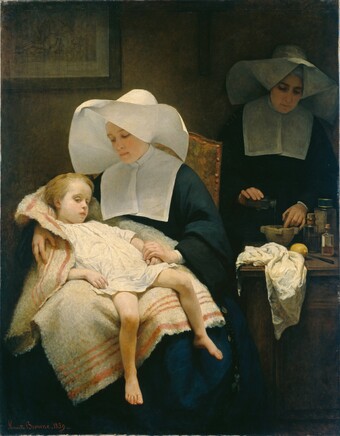
Die barmherzigen Schwestern, 1859
Öl auf Leinwand, 167 x 130 cm
© Hamburger Kunsthalle / bpk
Foto: Elke Walford
Diese Pressebilder stehen in druckfähiger Qualität im Online-Presseservice unter www.hamburger-kunsthalle.de zum Download bereit. Veröffentlichung nur gestattet im Zusammenhang mit einer aktuellen redaktionellen Berichterstattung über die Ausstellung in der Hamburger Kunsthalle. Jede andere Nutzung ist nicht gestattet. Die Bilder dürfen nicht angeschnitten und/oder mit Schrift überschrieben werden.
Publication only allowed in connection with editorial reports of the exhibition. Any other use is not allowed. The photos should not be cropped or overwritten with any form of text.
© Hamburger Kunsthalle / bpk
Foto: Fred Dott
Diese Pressebilder stehen in druckfähiger Qualität im Online-Presseservice unter www.hamburger-kunsthalle.de zum Download bereit. Veröffentlichung nur gestattet im Zusammenhang mit einer aktuellen redaktionellen Berichterstattung über die Ausstellung in der Hamburger Kunsthalle. Jede andere Nutzung ist nicht gestattet. Die Bilder dürfen nicht angeschnitten und/oder mit Schrift überschrieben werden.
Publication only allowed in connection with editorial reports of the exhibition. Any other use is not allowed. The photos should not be cropped or overwritten with any form of text.
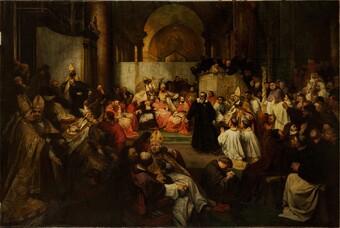
Galilei vor dem Konzil, 1861
Öl auf Leinwand, 282 x 429 cm
© Archiv Hamburger Kunsthalle
Foto: Christoph Irrgang
Diese Pressebilder stehen in druckfähiger Qualität im Online-Presseservice unter www.hamburger-kunsthalle.de zum Download bereit. Veröffentlichung nur gestattet im Zusammenhang mit einer aktuellen redaktionellen Berichterstattung über die Ausstellung in der Hamburger Kunsthalle. Jede andere Nutzung ist nicht gestattet. Die Bilder dürfen nicht angeschnitten und/oder mit Schrift überschrieben werden.
Publication only allowed in connection with editorial reports of the exhibition. Any other use is not allowed. The photos should not be cropped or overwritten with any form of text.
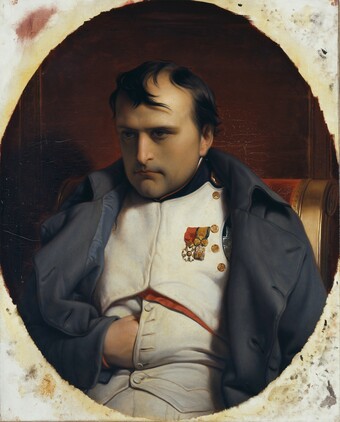
Napoleon in Fontainebleau, 1846
Öl auf Leinwand, 81 x 65 cm
© Hamburger Kunsthalle / bpk
Foto: Elke Walford
Diese Pressebilder stehen in druckfähiger Qualität im Online-Presseservice unter www.hamburger-kunsthalle.de zum Download bereit. Veröffentlichung nur gestattet im Zusammenhang mit einer aktuellen redaktionellen Berichterstattung über die Ausstellung in der Hamburger Kunsthalle. Jede andere Nutzung ist nicht gestattet. Die Bilder dürfen nicht angeschnitten und/oder mit Schrift überschrieben werden.
Publication only allowed in connection with editorial reports of the exhibition. Any other use is not allowed. The photos should not be cropped or overwritten with any form of text.
© Hamburger Kunsthalle / bpk
Foto: Fred Dott
Diese Pressebilder stehen in druckfähiger Qualität im Online-Presseservice unter www.hamburger-kunsthalle.de zum Download bereit. Veröffentlichung nur gestattet im Zusammenhang mit einer aktuellen redaktionellen Berichterstattung über die Ausstellung in der Hamburger Kunsthalle. Jede andere Nutzung ist nicht gestattet. Die Bilder dürfen nicht angeschnitten und/oder mit Schrift überschrieben werden.
Publication only allowed in connection with editorial reports of the exhibition. Any other use is not allowed. The photos should not be cropped or overwritten with any form of text.
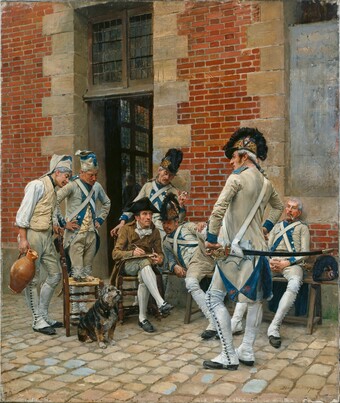
Das Porträt des Sergeanten, 1874
Öl auf Leinwand, 73 x 62 cm
© Hamburger Kunsthalle / bpk
Foto: Elke Walford
Diese Pressebilder stehen in druckfähiger Qualität im Online-Presseservice unter www.hamburger-kunsthalle.de zum Download bereit. Veröffentlichung nur gestattet im Zusammenhang mit einer aktuellen redaktionellen Berichterstattung über die Ausstellung in der Hamburger Kunsthalle. Jede andere Nutzung ist nicht gestattet. Die Bilder dürfen nicht angeschnitten und/oder mit Schrift überschrieben werden.
Publication only allowed in connection with editorial reports of the exhibition. Any other use is not allowed. The photos should not be cropped or overwritten with any form of text.
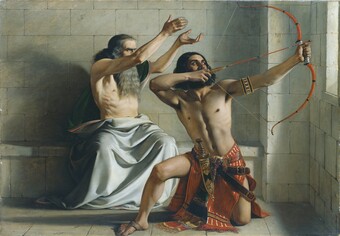
Joas schießt den Pfeil der Erlösung, 1844
Öl auf Leinwand, 76,3 x 109,5 cm
© Hamburger Kunsthalle / bpk
Foto: Elke Walford
Diese Pressebilder stehen in druckfähiger Qualität im Online-Presseservice unter www.hamburger-kunsthalle.de zum Download bereit. Veröffentlichung nur gestattet im Zusammenhang mit einer aktuellen redaktionellen Berichterstattung über die Ausstellung in der Hamburger Kunsthalle. Jede andere Nutzung ist nicht gestattet. Die Bilder dürfen nicht angeschnitten und/oder mit Schrift überschrieben werden.
Publication only allowed in connection with editorial reports of the exhibition. Any other use is not allowed. The photos should not be cropped or overwritten with any form of text.
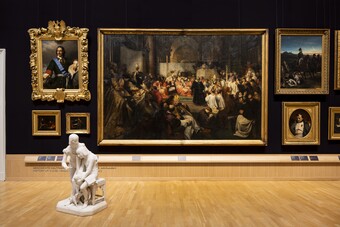
© Hamburger Kunsthalle / bpk
Foto: Fred Dott
Diese Pressebilder stehen in druckfähiger Qualität im Online-Presseservice unter www.hamburger-kunsthalle.de zum Download bereit. Veröffentlichung nur gestattet im Zusammenhang mit einer aktuellen redaktionellen Berichterstattung über die Ausstellung in der Hamburger Kunsthalle. Jede andere Nutzung ist nicht gestattet. Die Bilder dürfen nicht angeschnitten und/oder mit Schrift überschrieben werden.
Publication only allowed in connection with editorial reports of the exhibition. Any other use is not allowed. The photos should not be cropped or overwritten with any form of text.
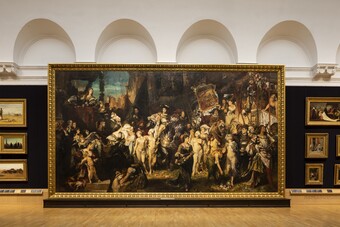
© Hamburger Kunsthalle / bpk
Foto: Fred Dott
Diese Pressebilder stehen in druckfähiger Qualität im Online-Presseservice unter www.hamburger-kunsthalle.de zum Download bereit. Veröffentlichung nur gestattet im Zusammenhang mit einer aktuellen redaktionellen Berichterstattung über die Ausstellung in der Hamburger Kunsthalle. Jede andere Nutzung ist nicht gestattet. Die Bilder dürfen nicht angeschnitten und/oder mit Schrift überschrieben werden.
Publication only allowed in connection with editorial reports of the exhibition. Any other use is not allowed. The photos should not be cropped or overwritten with any form of text.

Das Urteil des Paris, 1870
Öl auf Leinwand, 228 x 443 cm
© Hamburger Kunsthalle / bpk
Foto: Elke Walford
Diese Pressebilder stehen in druckfähiger Qualität im Online-Presseservice unter www.hamburger-kunsthalle.de zum Download bereit. Veröffentlichung nur gestattet im Zusammenhang mit einer aktuellen redaktionellen Berichterstattung über die Ausstellung in der Hamburger Kunsthalle. Jede andere Nutzung ist nicht gestattet. Die Bilder dürfen nicht angeschnitten und/oder mit Schrift überschrieben werden.
Publication only allowed in connection with editorial reports of the exhibition. Any other use is not allowed. The photos should not be cropped or overwritten with any form of text.
© Hamburger Kunsthalle / bpk
Foto: Fred Dott
Diese Pressebilder stehen in druckfähiger Qualität im Online-Presseservice unter www.hamburger-kunsthalle.de zum Download bereit. Veröffentlichung nur gestattet im Zusammenhang mit einer aktuellen redaktionellen Berichterstattung über die Ausstellung in der Hamburger Kunsthalle. Jede andere Nutzung ist nicht gestattet. Die Bilder dürfen nicht angeschnitten und/oder mit Schrift überschrieben werden.
Publication only allowed in connection with editorial reports of the exhibition. Any other use is not allowed. The photos should not be cropped or overwritten with any form of text.
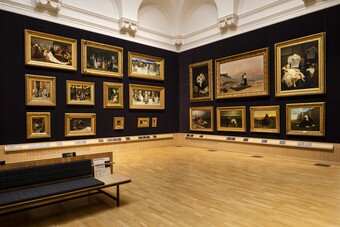
© Hamburger Kunsthalle / bpk
Foto: Fred Dott
Diese Pressebilder stehen in druckfähiger Qualität im Online-Presseservice unter www.hamburger-kunsthalle.de zum Download bereit. Veröffentlichung nur gestattet im Zusammenhang mit einer aktuellen redaktionellen Berichterstattung über die Ausstellung in der Hamburger Kunsthalle. Jede andere Nutzung ist nicht gestattet. Die Bilder dürfen nicht angeschnitten und/oder mit Schrift überschrieben werden.
Publication only allowed in connection with editorial reports of the exhibition. Any other use is not allowed. The photos should not be cropped or overwritten with any form of text.
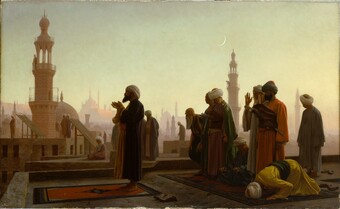
Das Gebet, 1865
Öl auf Mahagoniholz, 49,9 x 81,2 cm
© Hamburger Kunsthalle / bpk
Foto: Elke Walford
Diese Pressebilder stehen in druckfähiger Qualität im Online-Presseservice unter www.hamburger-kunsthalle.de zum Download bereit. Veröffentlichung nur gestattet im Zusammenhang mit einer aktuellen redaktionellen Berichterstattung über die Ausstellung in der Hamburger Kunsthalle. Jede andere Nutzung ist nicht gestattet. Die Bilder dürfen nicht angeschnitten und/oder mit Schrift überschrieben werden.
Publication only allowed in connection with editorial reports of the exhibition. Any other use is not allowed. The photos should not be cropped or overwritten with any form of text.
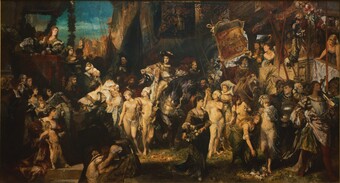
Der Einzug Karls V. in Antwerpen, 1878
Öl auf Leinwand, 520 x 952 cm
© Hamburger Kunsthalle / bpk
Foto: Elke Walford
Diese Pressebilder stehen in druckfähiger Qualität im Online-Presseservice unter www.hamburger-kunsthalle.de zum Download bereit. Veröffentlichung nur gestattet im Zusammenhang mit einer aktuellen redaktionellen Berichterstattung über die Ausstellung in der Hamburger Kunsthalle. Jede andere Nutzung ist nicht gestattet. Die Bilder dürfen nicht angeschnitten und/oder mit Schrift überschrieben werden.
Publication only allowed in connection with editorial reports of the exhibition. Any other use is not allowed. The photos should not be cropped or overwritten with any form of text.